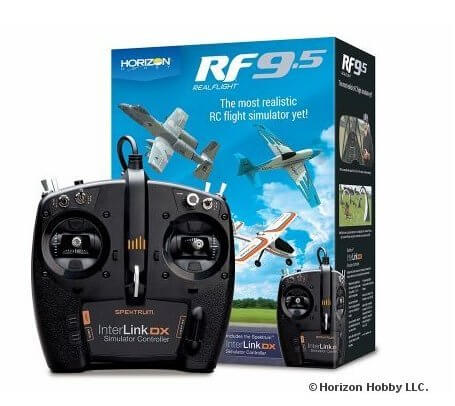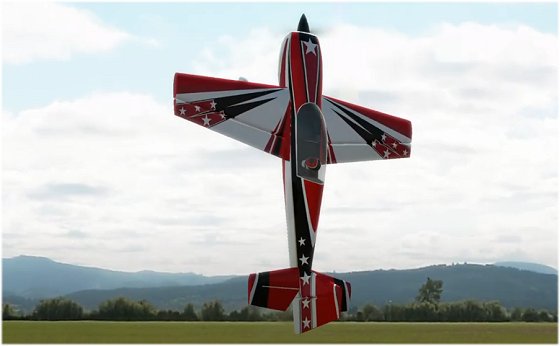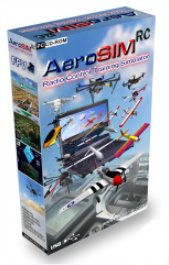RC Flight Simulators
- worth buying?
A commonly asked question by the tyro radio control pilot!
The truth is, RC flight simulators can give you a very realistic radio control flight experience, regardless of your experience level. And a sim is especially good if you intend to self-teach.
As with all computer graphic based programs, early 'sims' weren't that great, but today's technology means that your virtual flying session can be as close to the real thing as possible, without actually taking a trip to the flying field!
Essentialy, since the early 1990s rc simulators have evolved in to an excellent radio control flight training aid, second only to side-by-side club instructor training.
RC Flight Sim Popularity
A radio control flight simulator such as RealFlight®, for example, has become a very popular accessory for anyone wanting to learn to fly rc planes and other aircraft types.
Yes, it's an added expense but if you're even half-serious about the hobby then it's an expense well worth paying.

RealFlight™ is about the most popular sim currently available.
RealFlight is by far one of, if not the, most popular sim currently on the market. Phoenix was another but was sadly discontinued, quite why I'll never understand - it was an excellent sim and one I spent many hours on.
Such simulators have helped countless novice rc pilots learn the basics of radio control flight, and expert pilots rehearse their aerobatic and 3D routines to a faultless performance.
RC flying clubs also might have a sim in the clubhouse, and here in the UK the British Model Flying Association regularly take a sim-equipped trailer around the model shows for visitors to have a go.
How an RC Flight Sim Works
A good quality sim consists of powerful software, loaded onto your computer via a CD or internet download. The sim may or may not include a realistic transmitter-based interface controller.
Such a controller will of course be more basic than a proper rc transmitter ('Tx'), but will still look and feel the same to use, and feature the same 2 sticks and various switches.
The controller connects to your computer, and you fly your virtual aircraft in exactly the same way as you would at the field.
RC flight simulators that don't include a controller can be used with your normal transmitter, via either a USB wireless dongle or lead. Not all transmitters are compatible though, so always research this before you choose and buy a sim.
Using your own Tx is preferable to a controller, simply because it gets you more familiar with your own Tx that you will be using at the field. But with that said, the controller supplied with the RealFlight sim is realistic enough and is the perfect answer if you've yet to buy your own transmitter.
Whichever you do use, the virtual aircraft's response to your control inputs is precise and accurate, and the smooth graphics and realistic engine sounds (accurately matched to your throttle stick movements) really make you feel like you're standing on the flight line, flying the real thing!

Above: landing a seaplane on Phoenix rc simulator - pretty realistic!
Below: sims are perfect for honing those prop-hanging skills!

Sim Flying vs. Real Flying
As realistic as rc sim flying is, of course it's never going to be 100% accurate, despite the manufacturer's best intentions.
There's no question that flying a virtual radio controlled aircraft is a lot easier than flying the real thing. By that I mean that sim aircraft fly almost too well, with little or no idiosyncrasies programmed in.
Similarly, the wind effect on rc flight simulators doesn't typically emulate real-life wind, simply because simulated wind just isn't unpredictable enough. Kind of hard to explain, that one, but you'll see what I mean!
Also, using a sim's zoom feature can distract you from getting used to your plane's true position and orientation relative to you and the ground, because you have no peripheral vision to aid you.
Personally I always fly with the ground in view, because at least that way you can relate your virtual airplane's position to the ground, just as you do in real life rc flying.
But perhaps the biggest difference between rc simulator flying and real flying is the lack of the Fear Factor!
Crashing your beloved rc airplane is, sadly, an inevitable aspect of the radio control flying hobby. It is going to happen sooner or later (probably sooner, if you're learning...), and if it's a model that you have poured hours in to actually making, rather than a basic foamie Ready To Fly plane, then the fear of crashing it is much worse!
This is why, as rc pilots, we sometimes get nervous about flying - particularly landing, or trying that new aerobatic maneuver for the very first time. The risk of crashing is ever-present, and we really don't want it to happen.
On an rc flight simulator, however, that fear just doesn't exist. How can it? You're not flying an actual aircraft that you've paid good money for, and if you do crash and destroy your virtual plane then you simply hit the reset button and voilá, your plane magically reappears fully intact. If only that happens in real life!
So, in all seriousness, the lack of fear when rc sim flying is, in my opinion, a big thing. The problem that it presents, especially to the beginner rc pilot, is that it can give you a false sense of security. You'll always fly that little more recklessly on a sim, which can transfer to some bad habits on the flying field!
My advice is to always keep radio control simulator flying as realistic and as sensible as you can, and not treat your sim as a games console where the aim of the game is to try and crash as many times as you can in as short a time as you can!
Your Virtual RC Aircraft Collection
As you progress through the hobby, you'll inevitably find yourself accumulating more and more aircraft - this is the addictive side of the hobby!
One of the great things about rc flight simulators, such as RealFlight at least, is that they come with an impressive choice of virtual aircraft for you to fly.
From simple trainers to full-on gas rc turbine jets, and everything in between, you're spoilt for choice. One minute you can be flying a World War One biplane, the next minute an Apache helicopter. Or perhaps a Harrier jump-jet?!
Furthermore, the RealFlight aircraft collection includes the majority of Horizon Hobby's actual range, so if you own any of their models you can fly its virtual equivalent.
Most sims offer different camera angles so you can fly your aircraft from the ground, or in 'chase' mode, or even from inside the cockpit. This latter option is an excellent way of getting used to FPV flying, should you be interested in that.
Events and flying games such as spot landing, balloon bursting and limbo flying are available to really test your skills, and online multi-player mode is also a great feature, where available.
The better rc flight simulators feature a virtual flight school where professional rc pilots (from the real world) teach you everything from basic take off and landing techniques to advanced aerobatic maneuvers. Each lesson is narrated by the pilot, and Tx stick movements are shown so you can see exactly what inputs are being made.
RC Flight Sim Choices
RealFlight is about the most popular sim (as was Phoenix until its demise) and I can give it a personal recommendation. Even when I bought it (Version 4, many moons ago) it was impressive, but subsequent updates have just made it better and better.
Other sims include FMS which is either a free download or sold as a package with 4 or 6 channel controller (and sometimes even bundled in with an RTF aircraft deal), Clearview™, Reflex XTR™ and AeroFly Pro™. This latter one, AeroFly, is right up there in terms of quality and, at the time of writing, is the only sim which is truly Mac compatible.
 AeroSimRC is another one well worthy of consideration. Developed by an independent programmer, AeroSimRC is a very capable simulator that runs very smoothly on the computer. I'll be doing a review page on this one soon, but in the meantime you can find out more about this one on the AeroSimRC website.
AeroSimRC is another one well worthy of consideration. Developed by an independent programmer, AeroSimRC is a very capable simulator that runs very smoothly on the computer. I'll be doing a review page on this one soon, but in the meantime you can find out more about this one on the AeroSimRC website.
Keeping Updated
The radio control flying hobby is a fast moving one, and nothing stays still for very long.
RC flight simulator manufacturers are regularly releasing updates of their sims, whether it's releasing new aircraft or flying sites, or complete newer versions of the sim.
Make sure you get the most out of your sim by regularly checking the appropriate website for update news. Alternatively look for an update button within your sim, and this will lead you through the process.
Final thoughts... Is an rc flight simulator worth getting? Absolutely!
The advantages of using a sim far outweigh the cost of buying one, besides which a sim will keep you flying when the weather isn't being very co-operative.
Even if your budget doesn't stretch to an industry-leading product like RealFlight, a cheaper sim will still get you learning about radio controlled flying. Without doubt, an rc flight simulator is always going to be a good investment.
Please be aware that all the rc flight sims mentioned on this page were available at the time of writing this article, but of course it's possible that sims mentioned may get discontinued. Like poor Phoenix :-(
